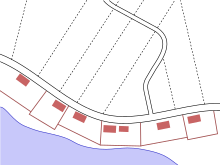Zeilendorf
The line village is one of the historically grown village forms in central Europe and consists of a single row of houses or Hofzeile which is regular and linear strung together. Zeilendörfer are terrain-related settlements that are often on the edge of wide valleys. The house plots are lined up along the village street. They have property strips adjoining the courtyard.
The farmsteads of this rural type of settlement are arranged strictly linearly, because they extend along a path or a small or larger body of water . Divided in half, they can be viewed as an anger village or a small street village.
The line village differs from the type of the row village or the Hufendörfer mainly in its regularity and closely adjoining buildings as well as the mostly smaller size.
Whether there are front gardens in front of the adjoining houses in a row village depends on regional tradition. Some narrow row villages could develop into an anger village (e.g. Jetzles near Vitis ) or a larger row village (e.g. Kirchschlag near Linz ) after structural measures . If the single-row settlement core is widened to the other side of the water, the associated strip-shaped parcels can now connect to the courtyards on both sides of the village street .
If the elongated fields behind a one- or two-line village are less than 10 meters wide (which in the past often happened through the division of inheritance), they are referred to as stripe or belt parcels in the Upper German-speaking area . By amalgamation and amelioration , more manageable properties can be created.
Relatively elongated row villages have sometimes emerged on rivers , which, due to their frequent flooding , have required the construction of the village road directly on the edge of the river terrace , where agriculture was limited to one side anyway . One such example is Spillern on the Danube (see 2nd web link), whose row of houses only became a two-sided street village in the last few decades. The saying goes from earlier times that in Spillern “the geese are only roasted on one side.”
The construction of the railway embankment (1841) also made the side facing the river flood-proof, and the earlier “back roads” now lead to the soon after the railway built country road , while a branch of the Danube silted up downstream.
See also
- Street village , marshland and forest hoof village , street perch village , railway settlement
- topographic object , road , stream (body of water) , moat , valley shoulder
